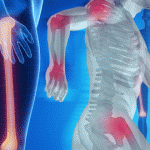(Reuters Health)—People with psoriasis, a chronic inflammatory disease, are more likely to have heart attacks and strokes when they have a family history of cardiovascular problems, a Danish study suggests. Psoriasis wasn’t associated with higher risk of heart attacks or strokes when people with the skin condition didn’t have a family history of cardiovascular disease,…

Patients with Gout May Not Understand Serum Urate Goals & Treatments
New research has found that a minority of gout patients understands the importance of their serum urate goals. Ted Mikuls, MD, MSPH, says the study shines a light on a gap in patient education providers can address…

Certolizumab Pegol Combination Therapy Better than Methotrexate Monotherapy in DMARD-Naive Patients with RA
A recent study found that certolizumab pegol plus methotrexate is effective in achieving sustained remission and low disease activity in patients with early active RA…
Arthritis Prevalence on the Rise, Creating Challenges for Healthcare System
Updated projections suggest that arthritis and arthritis-attributable activity limitation will remain large and growing problems for clinical and public health systems, which must plan and create policies and resources to address these future needs. By 2040, the number of U.S. adults with doctor-diagnosed arthritis is projected to increase 49% to 78.4 million. Can the healthcare system accommodate these projected increases? Not without changes. By 2025, the expected demand for rheumatologists is expected to exceed supply by 2,576 adult and 33 pediatric rheumatologists…

The Gut Microbiome Influences Postmenopausal Bone Loss
Bone health has been successfully improved by using probiotics to influence the gut microbiome in postmenopausal women with osteoporosis. New research has gained insight into this process, uncovering that sex steroid depletion increases gut permeability resulting in inflammation and pathology in mice. Treatment with probiotics also prevents this increase in gut permeability and bone loss associated with sex steroid depletion…

From the Expert: Tips for Research Grant Applications & NIH Funding
For researchers, obtaining a highly sought after NIH grant may seem impossible. But Martin Kriegel, MD, PhD, says collaboration and persistence can help. Here are a few tips to help your next grant application pass muster…

Comment Period Open for FDA Draft Guidance on Osteoporosis Treatments; Plus FDA Rejects Abuse-Deterrent Apadaz
The FDA is currently accepting comments on a draft guideline for osteoporosis treatments, which calls for more research into the long-term effects of drugs on bone quality. Also, the FDA has rejected an application for approval of Apadaz in its current form…
Doctors Blame Many Factors for Futile Care, Themselves Included
(Reuters Health)—Doctors who were asked about causes of inappropriate care at the end of life didn’t have to look far to place blame. They blamed themselves. Australian researchers interviewed 96 physicians from 10 medical specialties and asked them to describe situations when patients received end of life care that the doctors felt was inappropriate. Futile…

Antiphospholipid Antibody Syndrome Puts Pregnant Women at High Risk of Preeclampsia
A recent review investigated risk factors for preeclampsia in early pregnancy, finding that antiphospholipid antibody syndrome may be the strongest risk factor. As a result of these findings, researchers have compiled a list of risk factors to help clinicians determine which women are more likely to develop the condition and aid them in weighing treatment options…
California Insurance Commissioner Urges U.S. to Block Anthem-Cigna Deal
(Reuters)—California’s insurance commissioner on Thursday urged the U.S. Department of Justice (DOJ) to block health insurer Anthem Inc.’s acquisition of Cigna Corp., saying he is concerned it will raise premiums in the state. Dave Jones, who as insurance commissioner in California does not have authority to approve the deal, says he believes his recommendation will…
- « Previous Page
- 1
- …
- 522
- 523
- 524
- 525
- 526
- …
- 842
- Next Page »